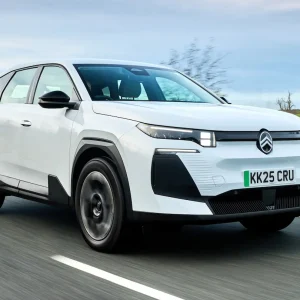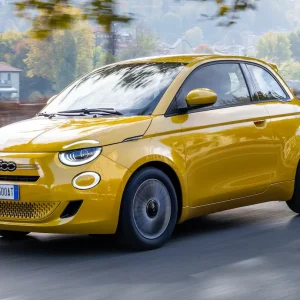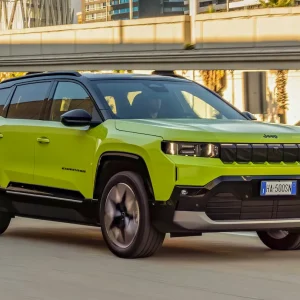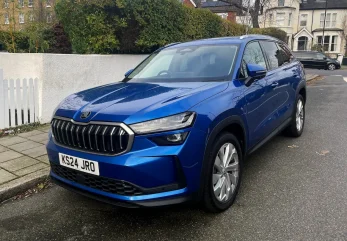
Final Report: Conclusions with caveats
At the beginning of this long-term test back in January I posed two basic questions, paraphrased again here: 1) could my general scepticism of plug-in hybrids be assuaged, through this Kodiaq PHEV’s longer-than-some 71 miles of EV-only range; and 2) would the novelty of running a Skoda as a long-termer for the first time remain after six months of testing?
To answer the second question first, and as mentioned previously, I have always had a soft spot for the first-gen Kodiaq model and I’m now running a Skoda Elroq so the brand is clearly doing many things right. That said, after six months with the Kodiaq Mk2 I found it less clean-cut and elegant than the Mk1 and less subtle in its angular and slightly crude face. It’s a fairly big car for UK roads too. At 4,758mm it’s 61mm longer than its predecessor, 18mm narrower, 3mm lower and with an identical wheelbase which makes its overall proportions look less planted to the road.
The Kodiaq’s cabin is more successful – and functional – as a design. Specific pluses include the auto gear selector moved to the right-hand side of the steering column to free-up more central storage and space for two wireless phone charging slots. Door handles are logically placed and easy to see, ambient and task cabin lighting is aesthetically pleasing and useful, and four USB-C ports plus Apple Carplay and Android Auto-compatibility cater for multiple on-board devices. But many brands offer these features. Where Skoda goes further and more originally is in its umbrella in the driver’s door panel and touchscreen wiper tucked into the central armrest, which is genuinely useful in removing multiple human paw prints from the glass.
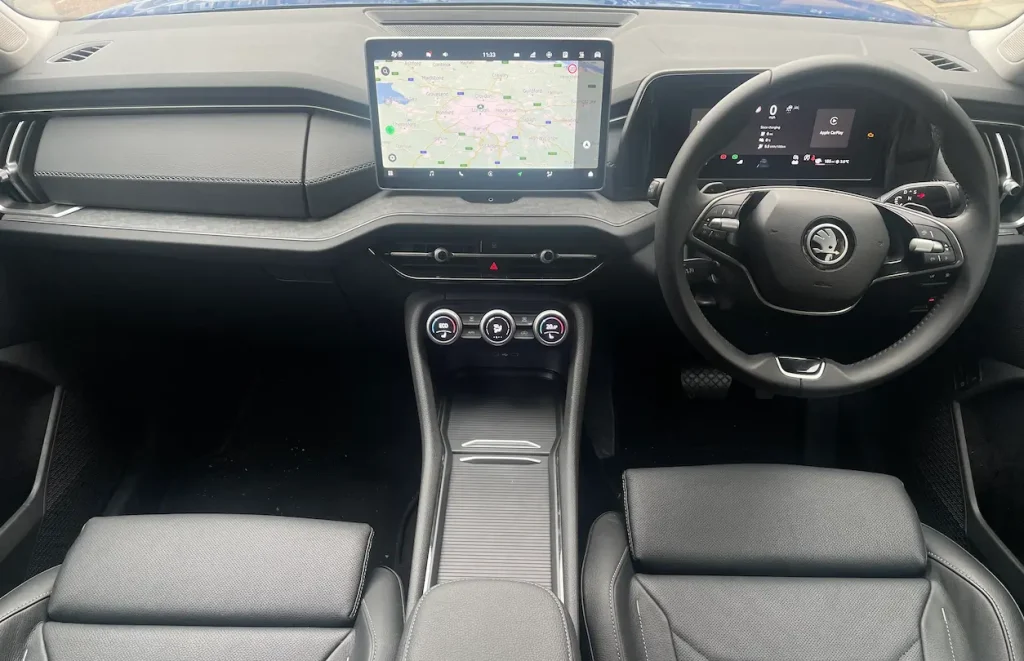
Head and legroom is very decent and in this five-seat PHEV version of the Kodiaq boot space is great – its 745/1945-litre min/max only topped by the non-PHEV five-seater’s 910/2105 litres.
Which brings me onto this Kodiaq’s PHEV-related aspect and that first sceptical question six months ago. With a combined 204hp 1.5-litre petrol-electric powertrain and the promise of 71 electric-only miles I had hopes of running this car mainly on electric power.
But in reality, that’s only possibly cost- and time-effective in the warmer months and preferably if you have off-street parking too. In the deepest winter months, that notional 71-mile charge often got halved in use and took too long to undertake, to the point that we stuck with petrol power until spring had properly sprung.
A better surprise was how the big Kodiaq drove. Twisting the steering wheel-mounted gear selector to ‘S’ for Sport, the formerly upset-sounding petrol engine made much perkier noises and via gearshift paddles – also mounted on the steering wheel column – allowed good control of the engine. Through fairly twisty roads and long curved ones, the car’s stayed remarkably balanced.
Less enjoyable was its low-speed, pottering-around-town idiosyncrasies. The Kodiaq seemed prone to jolting or lurching from a standstill, gave out a funny squeak when decelerating, had a late-to-activate Hill Hold function and proximity hazard and safe reversing alerts that overstayed their welcome on the centre screen – certainly long after any potential hazard had gone or reversing was done and forward motion made.
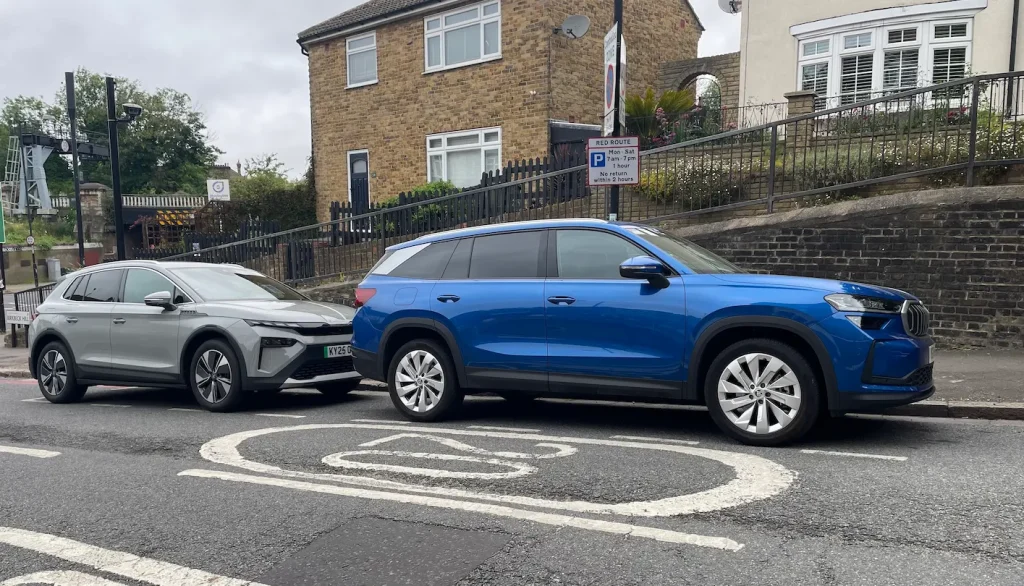
For fleets, the PHEV’s 11g/km CO2 rating correlates to a low 6% BIK band for the 2025/26 tax year we’re in and will be useful in keeping driver tax bills low across a three-year contract. But by 2028/29 this car’s BIK will jump to 18%, while zero-emission vehicles will only have risen to 7%. Meantime, if your employees have off-street parking for easy charging and make quite a few longer journeys where charging may be less easy, this PHEV makes good practical and tax sense. If not, I’d recommend a full EV – perhaps like the smart Elroq we’re now testing.
| Model | Skoda Kodiaq iV SE L (5 seat) |
| P11D price | £44,580 |
| As tested | £47,055 (OTR) |
| Official consumption | 578.4mpg |
| Our average consumption | 51.0mpg |
| Mileage | 3,935 |
5th Report: Simply clever (especially in summer)
The mysterious discovery happened when I was having a clear-out, as these things so often do. With the weather warming up nicely, and spring having fully sprung, I thought it was high time my winter car accessories were shifted back to the garden shed. But while rifling through the Kodiaq’s lidded centre armrest storage compartment and lifting out the windscreen scraper glove and more, I also found something else.
The little object looked a little like a chunky robot finger wrapped in faux suede that had lost its hand, or perhaps a well-insulated auxiliary mobile phone battery storage pack. Still puzzled, my better half quickly suggested it was a screen cleaner and so I tentatively gave it a go on the central touchscreen. It worked a treat, because that is exactly what it was designed for, especially in bright light when finger marks can really show up.
Looking down to the open centre console I then realised this Alcantara-esque clad robot finger had its own recessed resting place ahead of the cupholders and coin slots and behind the diagonal double charging slots for mobile phones. So that’s where it now sits proudly, and it hasn’t moved or rattled about since, due to the perfect way it fits its recess and because of its absorbent outer material.
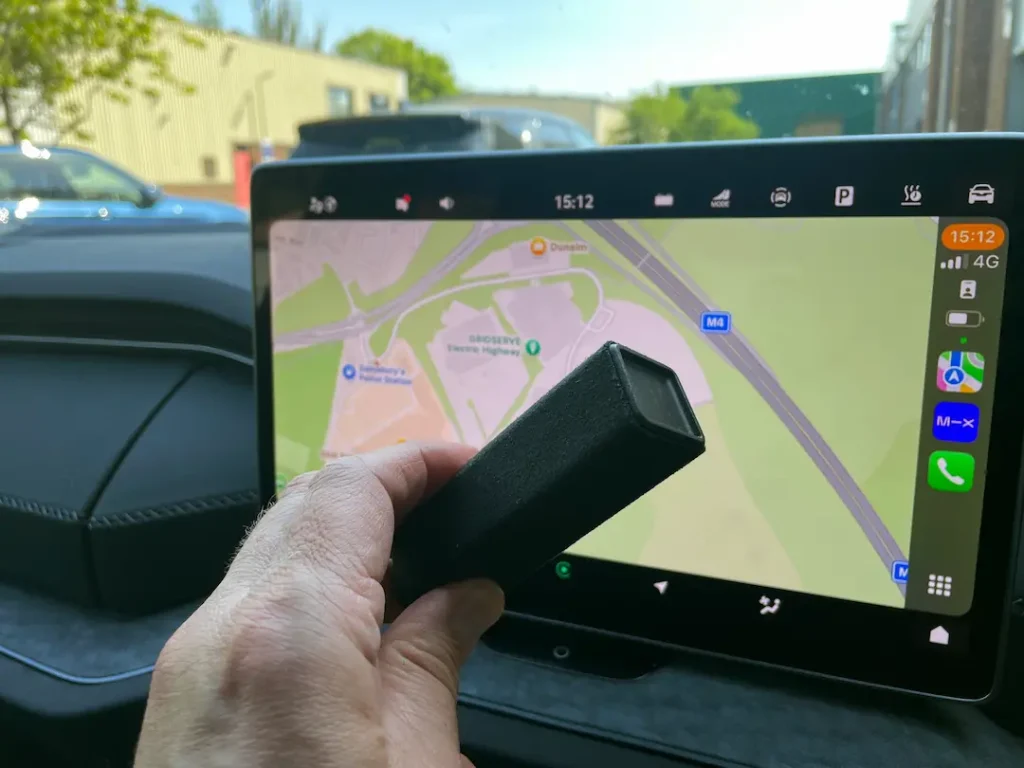
In art or design, this type of discovery is often referred to as ‘the second read’ – the thing you spot after the first glance – or in this tester’s case, some five months after you’ve been driving your long-term test car. Either way, it’s another great – and unusual – working example of Skoda’s long-held ‘Simply Clever’ tagline.
Up until recent warmer months, one aspect of this Kodiaq I was less enamoured with was the plug-in hybrid’s weak real-world electric-only range. The official data says 71 electric miles are possible but in the much chillier January and February months we were only gaining between 55-60 (notional) miles of electric-only range on the driver display and in reality running out of electric charge in half as many miles of use. So much so, we stopped charging with electricity from (pricey) public chargers and only filled up with petrol.
Returning to our trusty new Clenergy lamppost in spring, the last few charging missions have yielded 73, 74 and even a high of 81 miles on the driver display after a 100% overnight plug-in.
Better still, driving round the city, outer ring roads and motorways, without particular care to keep a lid on top speeds, the Kodiaq has provided about 55-60 electric miles before the petrol engine kicked in again.
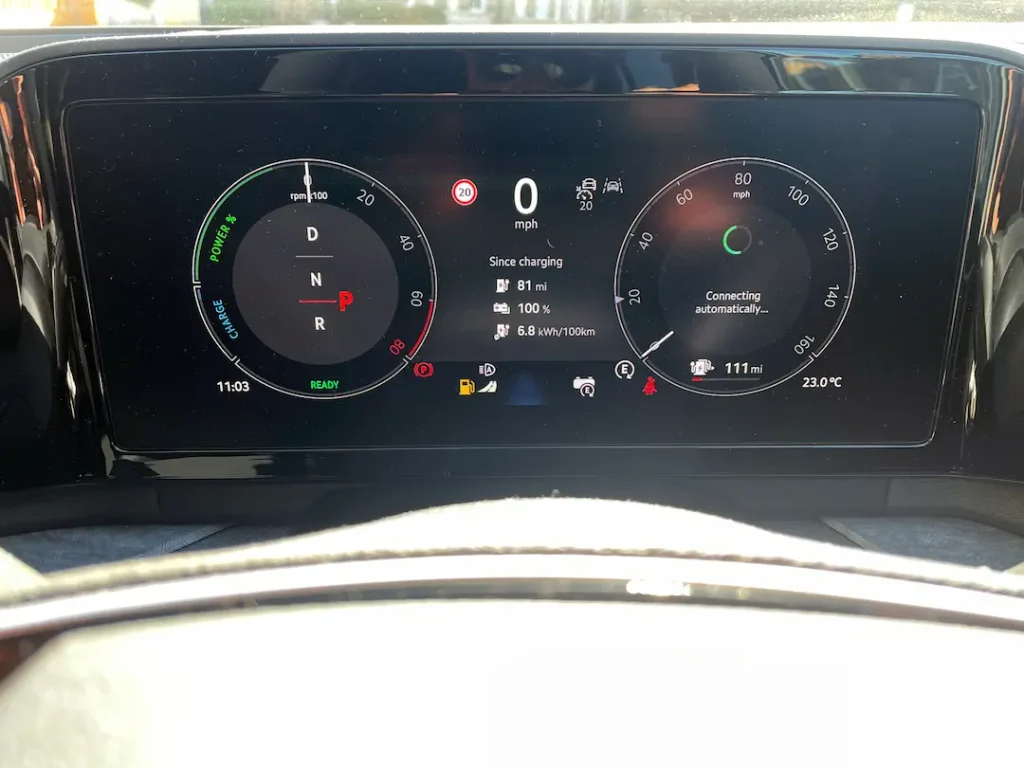
Notably, that result was achieved with the aircon working solidly to get the cabin down to about 17.5 degrees C as well, because in 25-degree starting heat outside and probably more inside, driving without A/C is not comfortable for anything more than short-term manoeuvres, unless you want your ‘hair shirt’ to get particularly hot – and you bothered.
The last petrol fill-up and separate electric charge gave a hybrid economy figure of 65.2mpg, which is much more like it, although still 513.2mpg off the PHEV’s official 578.4mpg figure, which is a measurement of utter nonsense (and functionally useless as a guide to the car’s economic performance). Of course, its associated 11g/km CO2 rating is very useful for a low 6% BIK band for the 2025/26 tax year just started. By 2028/29 this car’s BIK will jump to 18% though, in the same tax year that zero-emission vehicles will still only attract a 7% BIK rate. But meantime, especially if your employees need to undertake quite a few longer journeys where charging at either end can be sketchy, this PHEV makes good practical and tax sense.
| Model | Skoda Kodiaq iV SE L (5 seat) |
| P11D price | £44,580 |
| As tested | £47,055 (OTR) |
| Official consumption | 578.4mpg |
| Our average consumption | 65.2mpg |
| Mileage | 3,803 |
4th Report: Kodiaq PHEV does sporty shock
As solid family and company car transport buying choices go, the Skoda Kodiaq’s case is made of granite. No-nonsense, capacious, practical, pragmatic, middle-of-the-road, good value – and in plug-in hybrid guise – for now, still very tax-efficient and a little bit green, without the potential compromises for some drivers of going full-electric.
So up until now, the ‘S’ for Sport setting on the steering wheel-mounted gear selector to the right of regular ‘D’ for Drive had been an option I’d decided to leave alone. I even had the occasional private chuckle about it, and thought to myself, “What is Skoda thinking of by pretending to offer a sporty setting on its largest SUV?” But just the other week, when some decent open road presented itself on a longer mission I thought – in the interests of thoroughness in my long-term testing – I should give the selector a quick twist upwards. So I did.
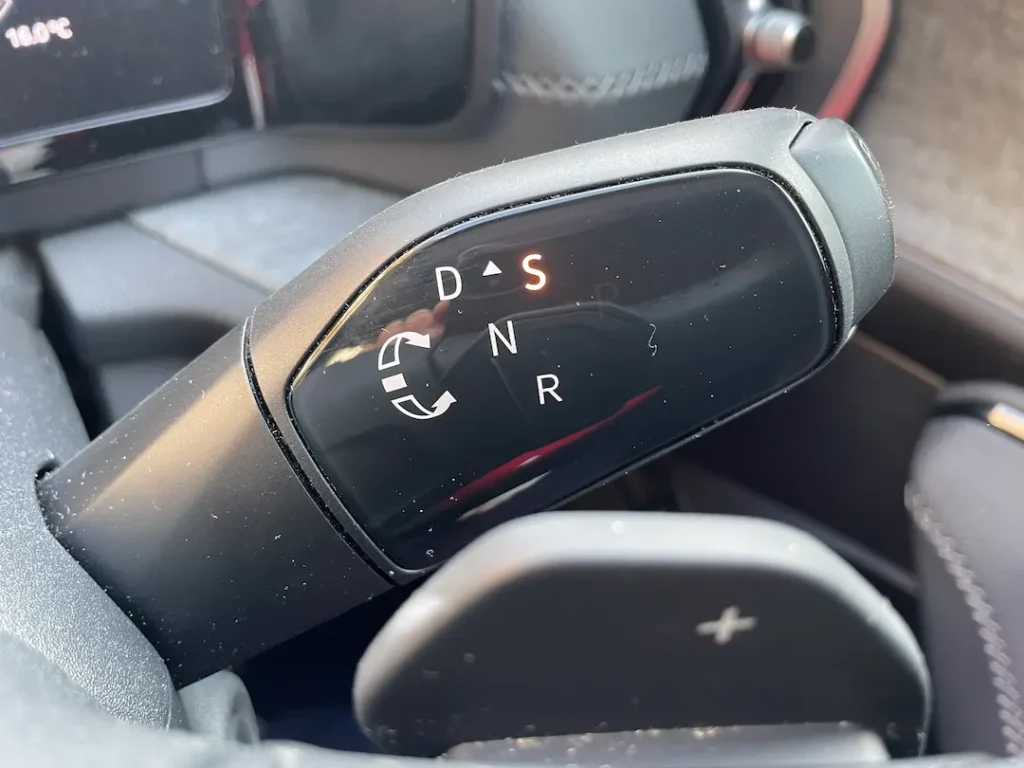
And I have to say, I had something of an epiphany. Straight away the formerly upset-sounding 204hp 1.5-litre TSI petrol engine started to make more perky noises and the car appeared to want to let me play. Via gearshift paddles – also mounted on the steering wheel column – I was able to control the car’s progress more smoothly and precisely, with the driver display quietly letting me know which ‘manual’ gear I was in – up to sixth – and when a little power boost had been delivered. Through fairly twisty roads and long curved ones, the car stayed remarkably balanced and the engine eager in a way I had not experienced before in this Kodiaq. After a period of driving I even gained some electric miles through brake regeneration for use later. Which is the only part of the process that reminded me of the model’s plug-in hybrid underpinnings.
The (relative) thrill of driving the Kodiaq PHEV in this way also reminded me that Skoda does have considerable skin in the racier side of the motoring game in its back catalogue, with both cool-looking and hot-performing sporty cars popping up at various points in its history. These include the 1971 Formule Skoda MTX (pictured below), 1975 130 RS (winning the 1981 European Touring Car Championship manufacturer’s title) and the 2010 Fabia Super 2000 (which won the Intercontinental Rally Challenge drivers’ and manufacturers’ titles). Many of these capable cars were on display at the brand’s excellent Czech museum next to its huge production facility in Mladá Boleslav when I visited almost a decade ago – and it is still well worth a visit if you’re a devotee of the marque and in the area.
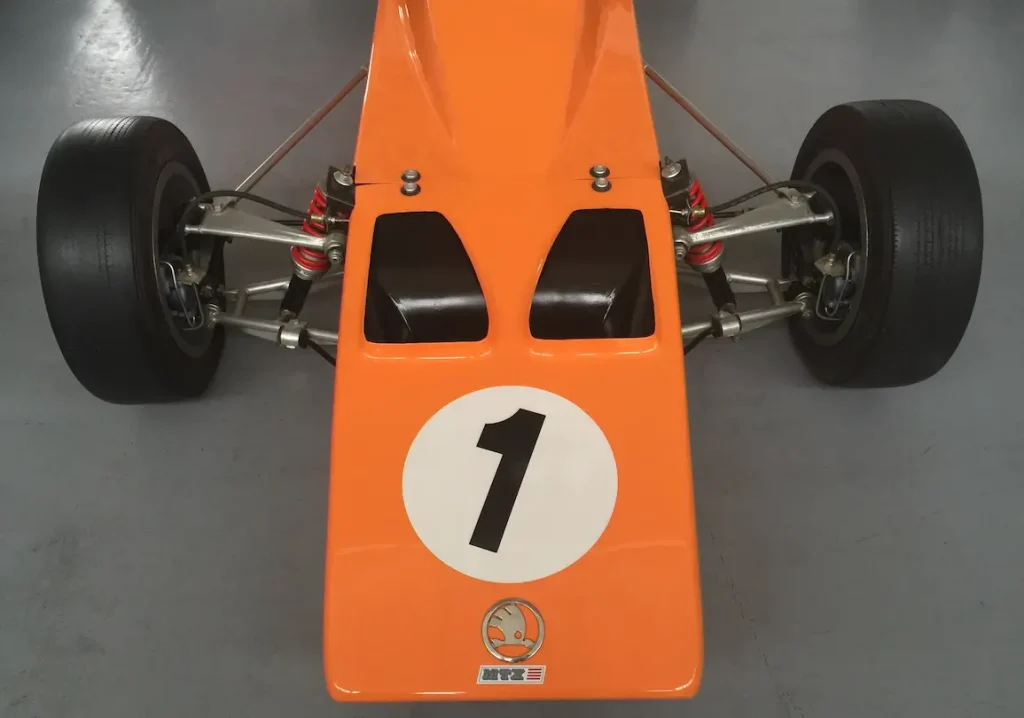
Of course, many Skoda drivers are aware of its now well-established modern era, go-faster vRS range – which references its sporty RS-badged past and there is indeed a seven-seat vRS version of the new Kodiaq powered by a 265hp 2.0-litre petrol engine available for £52,595. But that rather goes against the grain of the Kodiaq’s sensible characteristics mentioned at the top of this report and what it is surely supposed to be all about? And alas, or perhaps sensibly, that vRS model variant is not available for the Kodiaq PHEV. But the petrol-electric plug-in does still get that ‘S’ gear selector detail as a small gift to eco-aiming company car drivers who occasionally want to have a little driving fun. After all, the name of this test car’s paint is Race Blue metallic.
| Model | Skoda Kodiaq iV SE L (5 seat) |
| P11D price | £44,580 |
| As tested | £47,055 (OTR) |
| Official consumption | 578.4mpg |
| Our average consumption | 37.0mpg |
| Mileage | 3,283 |
3rd Report: PHEV fuel comparison time
In our second report on the Kodiaq, we decided to temporarily pause our regular electric charging because the January and February cold temperatures, hovering just above or below zero degrees, were making overnight charges at our local neighbourhood public charging point sub-optimal.
Adding between 55-60 (notional) miles of electric-only range on a few occasions in a row (compared to the official 71-mile top) at a cost of nearly £12 each time – even when charging mainly overnight to take advantage of the lower midnight to 7am 39pkWh tariff at our local (new) 3.4kW Clenergy lamp post public charger – the numbers on paper did not look good.
Add in the persistent cold weather and higher winter 60p electricity tariffs outside of those times – making a 15-hour plug-in a necessity to get a sufficiently full charge to warrant bothering – and the weak 31 miles real-world return (about half the stated range after our charge) and the effort and cost didn’t really make sense. Running on electric-only after that charge, and doing a few sums, the per-mile cost worked out at a whopping 39p.
To compare that to a petrol-only fill-up in similar temperatures and driving patterns – and with no electric charging in-between – we then ran the Kodiaq PHEV on petrol alone until virtually empty. After some 361 miles, forking out £64.75 to fill up (at £1.46 per litre), we returned 37.0mpg, roughly 18 pence per mile and more than half the price of electric-running.
After that petrol-only experiment and the brief arrival of some warmer weather in early March, we gave the battery another charge well before it was fully depleted and ten hours later – and with 13.5-degrees centigrade on the driver display at the time of unplugging – 65 miles of range showed up within the driver binnacle. Since then we’ve been taking it steady, still broadly on urban routes and testing what the car can achieve back in electric-only mode. So far we’ve noted that when turning on the air-conditioning, even just to fan level one, the notional mile counter drops by 13 miles. Keep the A/C off and the situation is much better, but the outside temperature has since dropped back down to six to eight degrees centigrade in London, so unless you’re wearing a big jacket, scarf, hat and some gloves, a little warm A/C is sometimes needed. We’re trying to be frugal – and patient.
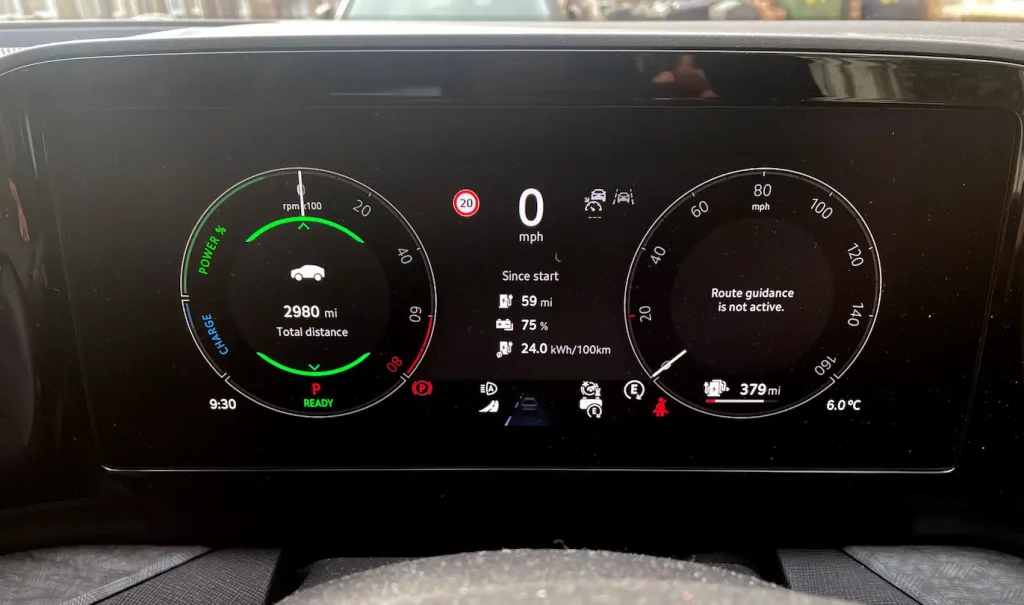
Meanwhile, the Kodiaq broadly does its main transportation job well, but does have its little idiosyncrasies. Like when putting the gear into ‘D’ for drive on the steering column and then gently pressing the accelerator the car often exhibits a slight jolt or lurch. Not always, but often enough to be disconcerting, and reported by more than one driver. Or its Hill Hold function that sometimes seems to think about working before it actually does, which is unsettling on an actual hill, or even just one with a slight gradient. Or the proximity hazard alert picture that takes over the centre screen when you’re trying to follow the satnav – and which stays active well after any potential hazard has gone – but apparently can’t be easily cancelled with the usual finger press of the ‘X in the circle’. Or the rear-view camera that helpfully appears in the centre screen to aid safe reversing but then stays on long after the driver has selected D and the car is in forward motion. Or the funny squeak the car sometimes makes when decelerating and the grumbly noise of the 204hp 1.5-litre TSI when called into action by itself, which suggests it’s working slightly harder alone than it is comfortable with. All of which sounds like a long list, but the Kodiaq is still a nice car to drive and its cabin a pleasant place to reside. I just hope the real-world EV range can improve.
| Model | Skoda Kodiaq iV SE L (5 seat) |
| P11D price | £44,580 |
| As tested | £47,055 (OTR) |
| Official consumption | 578.4mpg |
| Our average consumption | 37.0mpg |
| Mileage | 2,966 |
2nd Report: Interior motives
Regular readers of my long-term test reports will perhaps by now know I’m not a great fan of cars that ‘over-bleep’ in the name of safety. Our previous Lexus RZ was a stinker for it and turning the most unhelpful noises off in favour of driver self-determination was a multi-layered, frustratingly complex and potentially distracting – and therefore not very safe – manoeuvre.
Thank heavens for Skoda’s ‘Simply Clever’ multiple solutions to this legislative bind then. Indeed, there are two ways to turn off the bleeps in the Kodiaq. Option one is a two-press transaction from the main centre screen: first touch the (logical) symbol of a car surrounded by a protective circle and then you immediately get the full safety feature selection sub-screen – with individual features that can be switched on or off via the press-and-slide of a virtual button. The ones I require least often – like lane assist and speed warning – especially on wide 20mph sections of the South Circular with clear sight lines, are helpfully at the top of the list.
The second ‘bleep off’ option is just as easy and involves pressing a physical shortcut button on the right of the steering column, after which those same two potential safety items pop up in the driver display to be clicked on and off as needed. Either process still needs to be done at the start of every journey but it’s much easier than on the Lexus and so less fraught, which kicks off any mission more simply and calmly (which is good for safety).
The interior door handles are great too. That might seem like a mundane observation of a very mature item, where it could be thought that little new design time needs to be spent, but the Kodiaq’s are nonetheless clearly placed towards the top of the door, shiny and thus easy to find in the dark, logical to use and nicely sculpted to grip. The subtly textured and hatched door card pattern behind each handle is also smarter than equivalent areas in many older mainstream rival models, which one generation ago might have been merely dull, flat surfaces bereft of character. Slot in Skoda’s now well-established deployable umbrella in the driver’s door side – which I confess I like the idea of more than use, but still like – and the Kodiaq’s cabin feels like a quietly sophisticated place to reside.
Its decent height ‘no-lip’ boot load floor has come in handy too, most recently when schlepping DJ equipment – including heavy speakers – from home to venue and back again, without strain or over-reach. The five-seat PHEV boot’s 745/1945-litre min/max we’re testing might not be as big as the non-PHEV five-seater’s 910/2105 litres, but it’s still very capacious, with a few small cubby holes to the sides to slot winter accessories (or loose fruit).
Talking of the PHEV powertrain, we have to admit to temporarily pausing regular electric charging because in recent temperatures hovering just above or below zero degrees, an overnight charge at a local neighbourhood lamp post public charging point was only adding between 55-60 (notional) miles of electric-only range (compared to the official 71 top) at a cost of nearly £12. Worse still, on one occasion, in cold-weather real-world use, we only travelled half of that – 31 miles – before using up our electric range completely. That’s really not worth the effort or cost, but as we move into the warmer months of spring, we’ll get back to plugging in as much as possible and hopefully see some tangible economy improvements.
| Model | Skoda Kodiaq iV SE L (5 seat) |
| P11D price | £44,580 |
| As tested | £47,055 (OTR) |
| Official consumption | 578.4mpg |
| Our average consumption | 42.2mpg |
| Mileage | 2,673 |
1st Report: Kodiaq PHEV arrives
This long-term test is set to be a very interesting one because a) I’m somewhat sceptical of plug-in hybrids, but had my interest piqued by this particular model’s longer-than-most 71 miles of EV-only range and b) I’ve personally never run a Skoda as a long-termer and have always had a soft spot for the Kodiaq model.
I remember the positive reactions driving the first-generation Kodiaq for a week way back in the spring of 2017. In simple terms, it was the first Skoda I’d ever driven which onlookers really noticed and seemed to consider a tasteful choice, rather than just a value-led piece of functional transport. Much of that credit goes to ex-Skoda head of design Jozef Kaban – now incidentally design VP at MG’s Chinese parent company SAIC. The Mk1 design felt purposeful, different and great quality, all wrapped up in a mid-size SUV shape with five and seven-seat options which customers at that point weren’t used to seeing with a Skoda badge on its nose.
The first-gen Kodiaq made good on that initial impression, shifting nearly a million units worldwide in the following seven years. Even in its outgoing year of 2024, Skoda shifted 12,447 units in the UK alone, scooping the second-placed spot in the Skoda UK sales league table. Not bad at all. The second-generation Kodiaq only launched in the autumn of 2024 – so is still a new sight on the road – but aims to build on that success and now offers a plug-in hybrid model, which we’ll be testing for the next six months.
Size-wise, close PHEV competitors to the 4,758mm-long Kodiaq include the shorter Mazda CX-60 (4,745mm) and longer Peugeot 5008 (4,791mm). Proportionally, the new Kodiaq has stretched by 61mm over its predecessor, is 18mm narrower, 3mm lower and with an identical wheelbase. To these eyes, those changes make the Mk2 feel a little less distinctive, compared to the Mk1’s more elegant and nuanced proportions and body surfacing, while the Mk2’s less subtle front face also appears cruder. However, that more chunky look – especially in its more three-dimensional and two-plane grille – is already commercially successful on other Skoda models, so should appeal to many new and repeat Kodiaq customers too.
The interior of the Kodiaq feels very much ‘regular VW Group’ in style and execution, but there are some neat and specific details that chime with the Czech brand’s longstanding ‘Simply Clever’ tagline. The twistable auto gear selector has been moved to the right-hand side of the steering column to free-up more central storage and space for two wireless phone charging slots, while door handles are logically placed and easy to locate. There’s also a de-icer inside the fuel filler flap, spatially helpful as well as aesthetically pleasing ambient cabin lighting and easy-to-turn-off speed limit and lane keep bleep warnings only one layer deep within the 13in central touchscreen. Four USB-C ports (x2 front, x2 rear) ensure modern device charging needs are catered for and the vehicle is Apple Carplay and Android Auto-compatible. In real-life use, various family iPhones have easily connected to swiftly provide hands-free messaging, mapping, music and moving back and forth between the in-house screen and Carplay is also a doddle.
Rear-seat cabin room is decent by large petrol-powered car wheelbase standards and in this five-seat PHEV version boot space is great, its 745/1,945-litre minimum and maximum only bettered by the non-PHEV five-seater’s 910/2,105 litres. But perhaps the most surprising aspect of this PHEV is the promise from the combined 204PS 1.5-litre petrol-electric powertrain of 71 electric-only miles. We’ve only re-fuelled once each with electricity and petrol so far, but will be monitoring this aspect closely.
| Model | Skoda Kodiaq iV SE L (5 seat) |
| P11D price | £44,580 |
| As tested | £47,055 (OTR) |
| Official consumption | 578.4mpg |
| Our average consumption | 41.9mpg |
| Mileage | 2,127 |
Standard equipment on SE L: Seven airbags, collision brake system, cruise control with speed assist, electronic stability control, blind spot monitor, lane keep and road sign assist, LED headlights, front and rear parking sensors, keyless entry and start/stop, tri-zone climate control, heated front seats and steering wheel, 10.25in colour digital driver display and 13in central touchscreen with satnav, rear view camera, DAB radio, Bluetooth, wireless Apple Carplay and Android smartphone integration, two wireless smartphone charging pads, four USB-C ports (x2 front, x2 rear), power tailgate, 19in wheels, umbrella in front door.
Optional equipment: Electric tow bar with adaptor (£1270); Race Blue metallic paint (£660); Light and View Plus Package (£170); Winter Package (£320); adaptive cruise control (no-cost option)


